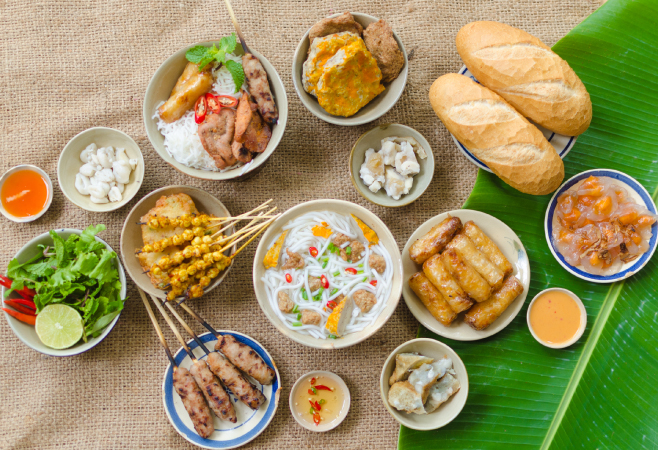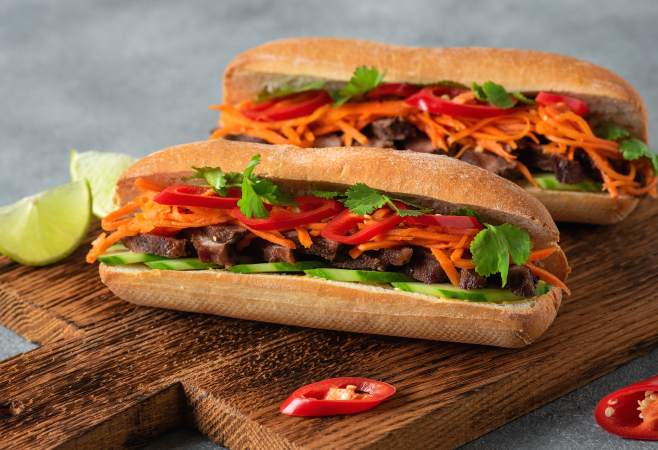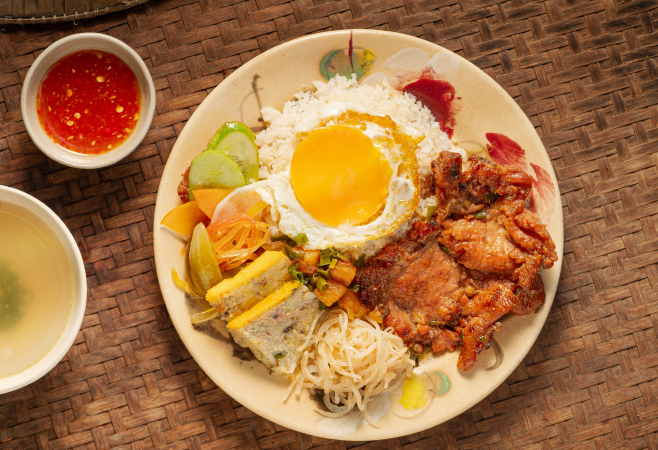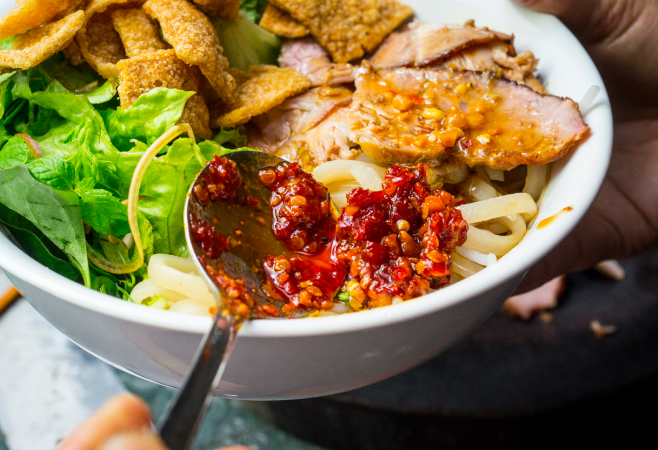Exploring The Tapestry Of Vietnamese Cuisine
Vietnamese cuisine is an exciting blend of textures, flavors, and aromas that captivate the senses and invite you to explore every corner of its culinary landscape. Vietnam's rich history and varied culture are reflected in its cuisine, from busy streets to peaceful family kitchens. This article will walk you through the tapestry of authentic Vietnamese cuisine, exploring the must-try Vietnamese dishes as well as demonstrating why it’s considered one of the popular Southeast Asian cuisines.
An Overview Of Vietnamese Cuisine
Vietnamese cuisine is well-known globally for its harmonious tastes and focus on making use of only fresh, and flavorful ingredients. Vietnamese cuisine has a rich cultural heritage and represents the nation's agricultural wealth as well as the centuries-long influence of different civilizations.

Vietnamese dishes are well-known throughout the world for their harmonious flavors
The Origins of Vietnamese Food
Early Influences
The origins of Vietnamese food, with an extensive variety of tastes, may be linked back to the ancient Vietnamese people's appreciation for the fertile Red River Delta environments. The cultivation of rice, a staple that supported communities and evolved to represent cultural significance, marks the beginning of this culinary adventure. Vietnamese cuisine has developed dramatically throughout history, driven by colonial influences and neighboring cultures.
Rice Cultivation
The groundwork of Vietnamese cuisine was laid by the Vietnamese people's rice cultivation in the Red River Delta. Rice production not only met essential needs but also shaped regional culinary practices and tastes. Nowadays. Rice-based Vietnamese meals have become a basic and valued part of daily living.
Chinese Influences: Stir-Frying and Soy Sauce
Early Chinese colonialism had a significant influence on Vietnamese home cooking practices. Chinese culinary influences transformed food preparation by introducing the practice of stir-frying. Furthermore, soy sauce, an essential part of Chinese cuisine, became an integral component of the Vietnamese palate, adding richness and savory sense to a wide range of meals.
Spices from Thai and Indian Traders
The colorful spices used in Vietnamese cuisine were introduced by merchants via Southeast Asian routes. Indian and Thai traders supplied unique spices that improved Vietnamese food with layers of complexity and scent. The sensation of this fusion was an important turning point in the history of Vietnamese culinary proficiency.
Colonial Impact on Culinary Identity
Vietnamese cuisine bears the permanent imprint of colonial powers, particularly the French. French ingredients and cooking methods were included, adding a level of refinement that led to a confluence that produced inventive and delicious dishes. The essence of Vietnamese cuisine was not diminished but rather elevated by this blending of cultures.
A Distinctive Culinary Identity
The characteristics of Vietnamese cuisine have formed as the result of the combination of early influences from rice cultivation, Chinese cooking practices, the introduction of spices by Indian and Thai traders, and ongoing cultural changes.

Vietnamese cuisine is a world of its own
Best Vietnamese Dishes You Must Try
To truly appreciate the best Vietnamese food, you must experience some of the most iconic Vietnamese dishes. Here are a few you simply cannot miss:
Pho
First up comes PHO, the most iconic Vietnamese noddle. With good reason, this Vietnamese food soup is often described as Vietnam's national cuisine. Although it originated in northern Vietnam in the early 20th century, it has subsequently spread throughout the country as a beloved staple.
Pho consists of rice noodles, herbs, a tasty broth, and meat—usually chicken (pho ga) or beef (pho bo). The broth, which is cooked for hours with spices and aromatics like cloves, cinnamon, and star anise, is what makes it so special. A complex, comforting flavor that is both familiar and unique is the end product.
Frequently, a platter of fresh herbs and bean sprouts is served alongside your pho order. Never be afraid to include these in your bowl; the way the flavors and textures blend is one of the things that makes pho so unique. To further increase the flavor to your preference, add a dash of chile sauce and a squeeze of lime.
Banh Mi
One of the best examples of how foreign influences have influenced Vietnamese cuisine is banh mi, a Vietnamese baguette. Originating in the 20th century, this sandwich blends Eastern and Western flavors to create one of the most iconic banh mi takeaway Vietnamese & Asian food options.
A crusty baguette filled with a variety of fillings is the fundamental component of banh mi Vietnamese food. Pork, pate, pickled veggies, cilantro, and chili are common fillings. Each bite is a pleasurable experience due to the combination of flavors and textures, which include crunchy, soft, tangy, savory, and often spicy.

A crusty baguette filled with a variety of fillings is the fundamental component of banh mi Vietnamese food
Goi Cuon
Fresh spring rolls, also known as goi cuon, are a nutritious and light choice that is ideal for Vietnam's hot weather. Unlike their fried cousins, goi cuon is made with rice paper wrappers that are just softened in water.
Usually, vermicelli noodles, shrimp, pork, and a variety of fresh herbs are used to fill the rolls. Goi cuon are as aesthetically pleasing as they are delectable because of the translucent wrapper that lets you view the colorful ingredients inside.
The dipping sauce is what truly makes goi cuon better. Although some places prefer a dip made with fish sauce, they are typically served with a thick peanut sauce.
Com Tam
A delicacy called com tam Vietnamese food is made of—you guessed it—broken rice grains. When cooked, the broken rice grain takes on a slightly sticky consistency. Flavors are well-absorbed by this stickiness. Additionally, broken rice cooks considerably more quickly because it is smaller.
Like many other Vietnamese dishes, you can find and enjoy Com Tam at any time of day. In Vietnam, pho is the most popular noddle in the north, whereas com tam is the most famous dish in the south, especially in Ho Chi Minh City. It’s a humble yet satisfying meal, representing the diversity of Vietnamese cuisine with rice.

A delicacy called com tam Vietnamese food is made of broken rice grains
Xoi
Vietnamese sticky rice (Xoi) is a popular Vietnamese food for breakfast, which is sold by both street vendors and high-end restaurants. As the name suggests, Vietnamese sticky rice is made of steamed glutinous rice (or sticky rice), together with other ingredients such as cereals (peanuts, mung beans, black beans, sesame), fruits (mango, sweet gourd), or meat (pork, bird, chicken). Vietnamese sticky rice is tasty, healthy, and especially affordable.
Cao Lau
The old town of Hoi An is synonymous with the Cao Lau noodle. Its noodles are special because they are made using ash from a certain kind of wood and water from a particular local well. It is questionable if this is still true now, but it contributes to the dish's mystery.
Slices of char siu pork, crunchy crackers, bean sprouts, and fresh herbs are arranged on top of the thick, chewy noodles. Only a little flavorful broth is spooned over the dish, which is hardly dressed.
The Hoi An Vietnamese cuisine offers a flavor of history in every bite and is a must-try when visiting this quaint town.

The Hoi An Vietnamese cuisine offers a flavor of history in every bite
About Street Food And Markets
Vietnam is a haven for street cuisine. The variety of real Vietnamese food that is available for very little money will astound you as you stroll through the busy marketplaces. In addition to being speedy and reasonably priced, street sellers in locations like Hanoi's Old Quarter or Ho Chi Minh City's well-known Ben Thanh Market serve some of the best Vietnamese dishes.
Any food lover must visit Ho Chi Minh City's Ben Thanh Market. It is the ideal location to enjoy Vietnamese street food at its best, with a variety of vendors offering everything from fresh fruit to prepared meals. The market operates during the day, but the Ben Thanh Market night scene is equally exciting, offering a different vibe as it transforms into a vibrant night market.
Be sure to check out Ben Thanh Market's opening hours to make the most of your visit!
Conclusion
Vietnam's food scene is as varied and dynamic as its geography. Every location, from the fertile delta in the south to the mountainous north, adds distinct flavors to the diverse tapestry of Vietnamese dishes. These best Vietnamese dishes are not just well-liked by visitors; they are also cherished by households and reet-side eateries along the country.
To fully immerse yourself in the vibrant world of Vietnamese cuisine and culture, you’ll need a visa to enter Vietnam. The good news is that getting a Vietnam visa online is quick and convenient. The Vietnam e-Visa is eligible for more than 80 nationalities. You can easily apply for your Vietnam e-Visa via the Vietnamvisacorp portal without the need to visit the Vietnamese Embassy. Don’t miss out on an adventure that awaits you in Vietnam and get ready for an incredible trip!
Related Articles
- Custom In Vietnam: A deep dive into Vietnamese traditions
- Retire in Vietnam: The ultimate guide for a dream retirement
- Trang An, Vietnam: A journey through Vietnam's natural wonder
- Vietnam Metro: The future of urban transportation in Vietnam
- Main districts of Ho Chi Minh city: Iconic landmarks & travel map
HOW CAN WE HELP?
APPLY WITH CONFIDENCE










